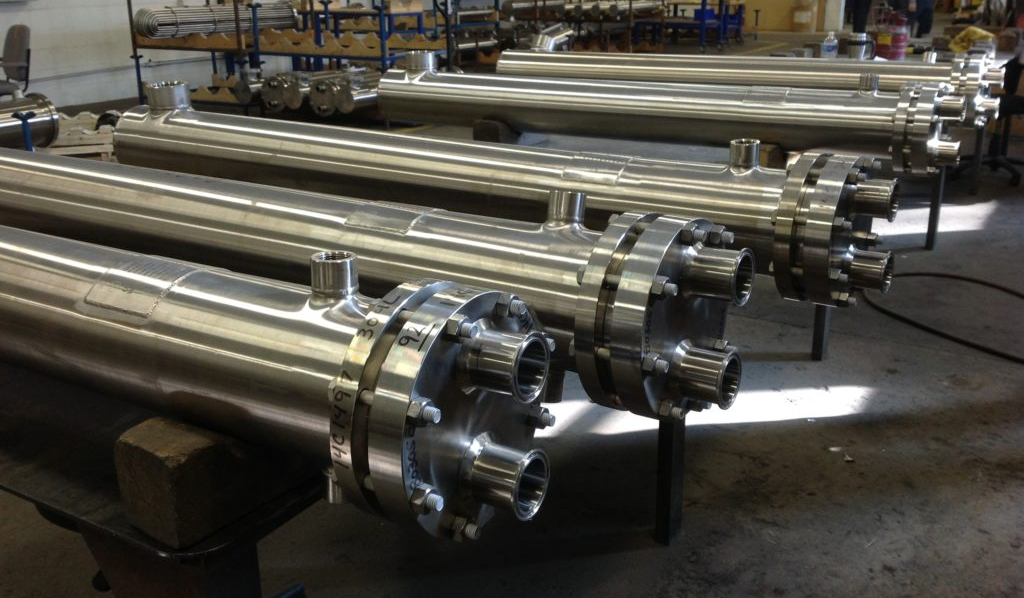Heat exchangers are everywhere. They are in cars (radiators), homes (refrigerators and air conditioners), factories, food processing, breweries, electronics cooling, and pharmaceutical manufacturers, to name a few. These implements help in everyday tasks like cooling air in buildings and regulating car engine temperatures. For businesses they serve to assist industries in cooling or heating liquid, gas, or vapor thus conducting vital processes or meeting essential production needs.
To achieve these temperature changes, heat exchangers facilitate the transfer of heat between two different fluids – called media – without mixing them together. One fluid loses or gains heat by transferring or receiving heat energy from the other fluid. The utility media (or utility fluid) is the substance – like cool air or water – that induces the temperature change; common fluids used as coolers include water, deionized water, and water/glycol solutions. The process media (or process fluid) is the substance that undergoes a temperature change through absorption or loss of heat. Common fluids cooled through heat exchangers include oil, water, and air.

There are many different types of heat exchangers with multiple variations (even within the major design types), as well as specialty exchangers suitable for more specific applications. Some of the most common types are:
- Shell and tube heat exchangers: This type of heat exchanger is most commonly used in industrial settings. This design utilizes a series of tubes containing fluid to be cooled; this bundle of tubes is placed inside a shell – a cylindrical pressure vessel. A second fluid flows through the shell and over the first fluid tubes, all in order to transfer heat. Typical applications for this model include oil refinement, industrial paint systems, vapor recovery, pharmaceutical and biotech process, preheating, and air conditioning.
- Plate and frame heat exchangers: The construction of this heat exchanger involves thin metal alloy plates, held together by a steel frame. There are two inputs and two outputs – one for each media – with spaces between the plates alternating between hot and the cold liquids, thus allowing the heat transfer to occur. This model is known for its high heat transfer efficiency, ease of maintenance, and for being compact.This particular design is growing in popularity, and can be used in a wide range of heating and cooling applications across various industries including chemical, petrochemical, oil and gas, paper, wastewater treatment, and pharmaceutical.
- Dimple plate/plate coil: Although not as widely used as the prior examples, dimple plate heat exchangers can offer the best of both worlds. They are inexpensive, compact, and customizable. This is due mostly to its straightforward design: two steel sheets are welded together, but maintain enough space between the plates for fluids to flow. This model’s specialty is in applications where one fluid is static. The most common usage is as tank jackets for beer and dairy tanks. Dimple plate models are often used to cut energy costs, or to comply with environmental regulations.
Selecting a Heat Exchanger
Choosing the right heat exchanger entails awareness of multi-dimensional factors, such as fluids, dynamics of heat transfer, and capabilities of specific devices. Some of factors impacting heat exchanger selection include:
- Product Nature – Characteristics of the product fluid help determine which heat exchanger is most appropriate. For example, is the product a viscous, or an otherwise difficult fluid? Some heat exchangers handle viscous products efficiently, while others may run into clogging problems. Heat capacity properties also affect selection, as fluids with a low heat capacity will require a larger area to do the same work as those with a higher heat capacity.
- Target Temperature – Taking target temperatures into account is important in making an appropriate heat exchanger selection. Some models are proficient at high temperatures, while others are designed for heat exchange at lower temperatures.
- Velocity – Certain fluids require high enough velocities to ensure solids are maintained in suspension, and that settling does not occur. It is therefore important to select a heat exchanger capable of handling the required velocity for both fluids, and thus reduce risk of fouling.
Acuity Knows Heat Exchangers
Choosing a heat exchanger can be complicated. Fortunately, Acuity’s extensive experience working with heat exchangers enables us to capably guide customers on how to select correct types and sizes (in part by providing a comprehensive sizing document). Acuity deals in almost all heat exchanger types used in the sanitary market, and thus can guide customers to exactly the right manufacturer.



Leave a Reply
You must be logged in to post a comment.